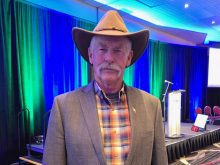The point of marketing is to stand out from the crowd. Emphasizing the environmental angle of agricultural direct marketing is one way to do it.
Agriculture’s environmental track record is under greater pressure from its customers and government. A recent example is the controversy over the federal government goal to reduce nitrogen fertilizer emissions by 30 per cent by 2030. As well, the livestock sector is dealing with concerns about greenhouse gas emissions from cattle.
Why it matters: Regenerative agriculture concepts can be used for direct marketing and may resonate with a segment of consumers.
Read Also

Five new CWD cases confirmed in Manitoba
Chronic wasting disease (CWD) has been found in five more Manitoba deer, including in two new municipalities without previous cases of the disease.
Federal and provincial money has been earmarked for cover crops, perennial cover and rotational grazing, practices linked under the umbrella of regenerative agriculture or holistic management.
Those practices may be a valuable selling point for farms that sell directly to consumers who want to reduce their environmental footprint, according to Ellen Goddard, co-operative chair of agricultural marketing and business at the University of Alberta.
They might not sit as well with producers who are put on the defensive if they don’t use such practices.
“There is always a concern, when somebody promotes a particular type of production, that somehow or other it stigmatizes other types of production,” she said.
Goddard used the example of fast-food chain A&W and its hormone-free beef campaign that sparked farmer outrage and calls for boycotts in the mid-2010s.
More farmers want to test practices with an eye to sustainability and consumers are demanding it, she said.
Other pressure is coming from commodity buyers. Agribusinesses are being pushed by their investors to include sustainability metrics, said Goddard, and that filters into producer contracts and production expectations.
Cameron Hodgins, who direct markets beef, pork, poultry and honey on his farm near Lenore, Man., says he hasn’t seen much blowback from his advocacy of regenerative agriculture principles.
He tagged community and peer networks as main drivers for the philosophies of soil health, biodiversity and sustainable production that he uses on his farm.
Direct marketing does not necessarily involve regenerative agriculture, he said, though some experts have noted links between the two.
“We don’t necessarily market ourselves as regenerative,” Hodgins said. “We don’t put that label on it, but when we’re marketing, we want to make sure that we convey that message to the consumer, that we are taking the land and habitat into consideration when we do our ag practices.”
Lydia Carpenter of Luna Field Farm near Belmont avoids the regenerative label in favour of outcome-based messaging that better represents her farming practices.
[RELATED] Country Guide: Finding a new way for agricultural success
“We’re focused on quality of beef,” she said. “But we’re also focused on managing our land in such a way that pays us dividends…I don’t think that many producers would disagree with that.
“When we’re trying to communicate about the beef that we produce, I would say that comparisons are not very helpful. Rather, [we’re] focusing on why we do what we do.”
The reasons range from maximizing product quality to farm ecology, soil health and increasing the water-holding capacity of the land.
“I think, too, there’s a lot of peer to peer exchange that can happen if we are not necessarily trying to compare apples to oranges or ostracizing other people in the grazing community,” Carpenter said.
Goddard notes the disparity between direct marketing farms (which make up less than 14 per cent of farms nationally) and the titans of conventional agriculture.
In her experience, there is less inclusion of small landholders in general farm groups. As well, programs are often geared toward conventional producers. Farm groups have resources for large-scale ad campaigns, unlike direct marketers, she added.
Sell and let sell
All farmers are passionate about their production and regenerative agriculture does not have a monopoly on innovation, said Goddard. For example, livestock sectors have willingly exceeded animal welfare standards and developed their own certification and verification programs.
“At the end of the day, all farmers are natural environmental stewards,” said Canadian Farm Management Council executive director Heather Watson. “If they weren’t, they would not be able to rely on the land, air and soil to continue to provide food, fuel and fibre. And differentiating your business from another is the name of the game when it comes to running a business.
“In saying that, I personally feel the world needs agriculture and there is opportunity for everyone in agriculture. In such a volatile business environment of increasing complexity and uncertainty, and with so much pressure on agriculture and our farmers to maintain the trust of the general public, I hope others feel the same. United we stand, divided we fall.”















